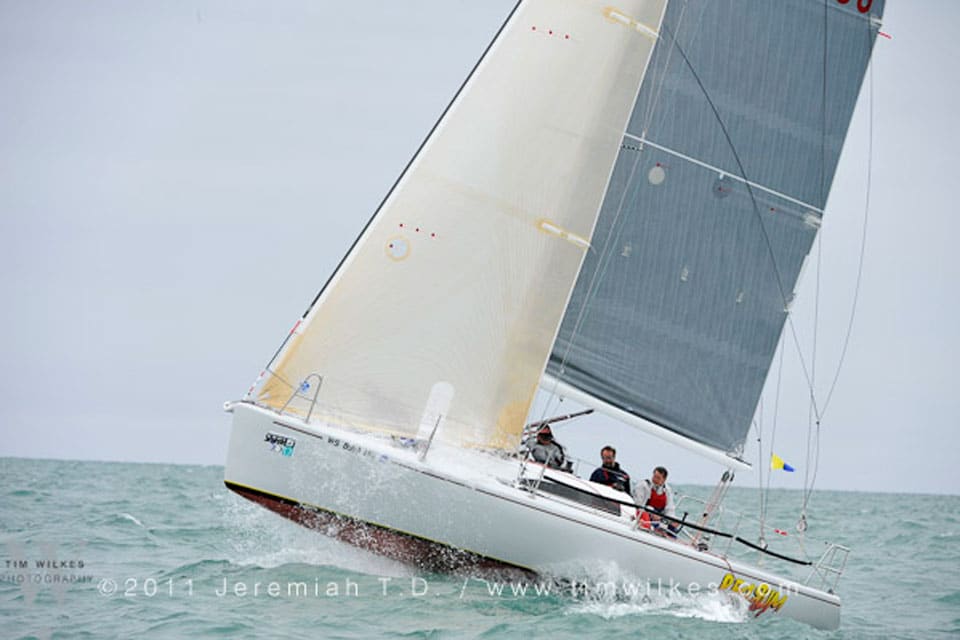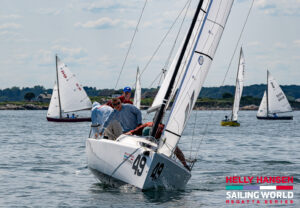
Redrum960
“No way! No way!” shouted Scott Bruesewitz, stomping up to the podium to accept the award for first-place overall at the 2011 Sperry Top-Sider Chicago NOOD, which includes an invitation to compete at the NOOD Championship regatta in the British Virgin Islands come November. “You’ve got to be kidding me!”
NOOD winners are always happy campers, but Bruesewitz takes the cake. He was over the top, high on life, in utter disbelief. “I figured there was no way,” says the skipper of the Mt. Gay 30 REDRUM, which came out on top of a PHRF 3 division in which a mere 4 points separated the top four boats—sequentially, Jack Amedio’s Farr 395 Chaos, Mitchell Padnos’ J/124 Sufficient Reason, and Robert McManus’ J/130 Edge. “We’ve won the NOODs a few times before in the Tartan Ten, and I thought we might’ve had a chance then, but we really weren’t expecting it this year.”
Compared to the big-fleet, one-design competition he’s used to the T-10 fleet, Bruesewitz was facing a different beast at the helm of the smallest boat in the 10-boat division. “We got out there on the first day and were like, ‘This is going to be tough,'” says the Milwaukee native. “We just knew we had to have clear air, clear air, clear air. The sail area on some of those other boats was huge, and we knew if we got stuck underneath them we’d have zero wind. We wanted to control our options and be able to tack away, so at the starts—I always do a port-tack approach—if we saw a huge hole, we’d take it. Otherwise, we’d duck and tack behind the pack, where we knew there was room.”
How REDRUM came to win the Chicago NOOD is something of a saga. Bruesewitz has been working on boats at Milwaukee’s Harborside Yacht Center since 1972. In his spare time, he buys beater T-10s, whips them into racing shape, and flips them. He once restored a T-10 that had a three-foot tree growing out of the deck. The buyer of that boat called Bruesewitz a few years ago and said, “You like projects? I’ve got a project for you!”
There was a partially built Mt. Gay 30 up for grabs at Rhode Island’s New England Boatworks, and it didn’t take long for Bruesewitz to show up with his trailer. “It was just a deck and hull skin. No keel. No rudder. A mast, but no rigging. And a bunch of parts. We showed up Thanksgiving weekend, and when we strapped it to the trailer, the boat would squeeze in and out like a beach ball, bowing this way and that. There was no structure. Twenty-six ratchet straps later, we’re driving down the highway to Milwaukee.”
Bruesewitz brought REDRUM to a vacant manufacturing warehouse in Milwaukee. “The space had overhead cranes, so were were able to go up and down fitting the bulkheads,” says the 55-year-old. “I hired Jeff Van Gorkum (of Van Gorkum Yacht Design) to help me with the project. He has a Mt. Gay 30, and he knew just what to do. He was like, ‘What do you want to do with the boat?’ And I was like, ‘I want a rocketship. I want a 30-footer that will do 20 knots.’
“Jeff was like, ‘I think you can probably do that,'” continues Bruesewitz. “We had the keel made in Mexico. It’s a stainless-steel, wing-frame, L-shape keel with a lead bulb. There’s a carbon-fiber rudder, and we have Hall spars. The first time we took it to the NOOD, the forecast was for 15, but we rounded the windward mark and the wind was blowing 20 snot. We did a jibe set, forgot to release the runner, and laid the boat on its side. We got it up, the chute pops, we round up. The third time was the charm, and the rig came tumbling ove the bow.”
The dismasting didn’t slow REDRUM for long, and the team—which also includes Bruesewitz’s wife, Debbie, Tom Pease, Perry Lewis, Amy Simonson, and Matt Ayers—showed up at this year’s regatta ready to win. “We don’t come to compete,” says Bruesewitz. “We come to win. With all my boats, budget is no object. That’s the game. This is the game. It’s all about working with the design and making the boat right, putting yourself in a position to win. We put the boat in heated storage every winter and make a list of what doesn’t work just right. We turn over the sail inventory every two years.
“Preparation, preparation, preparation,” he continues. “I learned that from Dennis Conner racing SORC in the ’70s. So many people get frustrated that they can’t win, but they don’t have the gear. They’ll say, ‘We brok a jib sheet.’ How can you break a jib sheet? It’s $25, and it’s going to cost you the regatta? You’ve got to give yourself the opportunity to excel. We go to the North U classes all winter long. We come down to Strictly Sail Chicago and do some seminars.”
The time put in at the boatyard and in the classroom in the offseason is all part of the lead up to major summer events like the Chicago NOOD. “You learn so much at the big regattas,” says Bruesewitz. “I always tell people in Milwaukee, ‘You’ve got to go to the NOODs. It’s Chicago. It’s 90 miles away.’ They’ll be like, ‘I don’t know if I can get the boat there.’ and I’m like, ‘Get it there. You’ll learn so much sailing in a different venue.’
“We try to learn something every time we go out,” he continues. “This weekend, we learned that we need to work on our gray area, between 8 and 14 knots, where it gets to be too much for our No. 1 genoa and too light for our No. 3 blade. We don’t have a No. 2, and if we’re going to make one, we might need to change the rig to get the spreaders out of the way. It’s either that, or we need to learn how to do peels on a one-mile beat. It’s unheard of, but we might do it. We’re also thinking about moving the cabin top forward to lengthen the cockpit. We can only fit three people in there now, and you need four. I mentioned that to Matt, our bowman, and he comes up the ladder with a Sawzall, a magic marker, and a tape measurer, and he’s like, ‘Where do you want it?’ I was like, ‘Settle down, settle down.’ But that’s where we’re at. We’re willing to do what it takes to make the boat just right.”
- For more coverage of the Sperry Top-Sider Chicago NOOD, click here.
- For results, click here.
- For photos by Jeremiah Tamagna-Dar/ www.timwilkes.com, click here.









